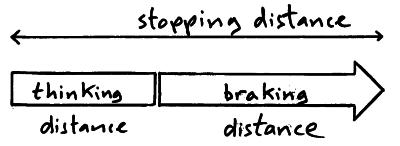When a car is travelling at a steady speed the frictional forces (like air resistance) are balanced by the driving force of the engine. The resultant force is zero.
The greater the speed of the car the greater the stopping distance.
Stopping distance
The overall stopping distance for a car is made up of two components the thinking distance and the braking distance.

stopping distance (m) = thinking distance (m) + braking distance (m)
Thinking distance
This is the distance the car travels forward from the moment they see a problem to the moment they put their foot on the brake, it is determined by the reaction time of the driver.
The thinking distance is longer (i.e. the reaction time is slower) if the driver is tired, is distracted, has taken alcohol or drugs.
Braking distance
The breaking distance is the distance the car travels forward from the moment the car begins breaking to the moment it has been brought to stop.
The braking distance is longer if the road is wet or icy or the tyres and brakes are worn.
Energy in braking
The kinetic energy of the car is converted into thermal (heat) energy in the brakes by friction. If the cars wheels lock and the car slides the kinetic energy is converted into thermal (heat) energy because of friction between the tyres and the road.



